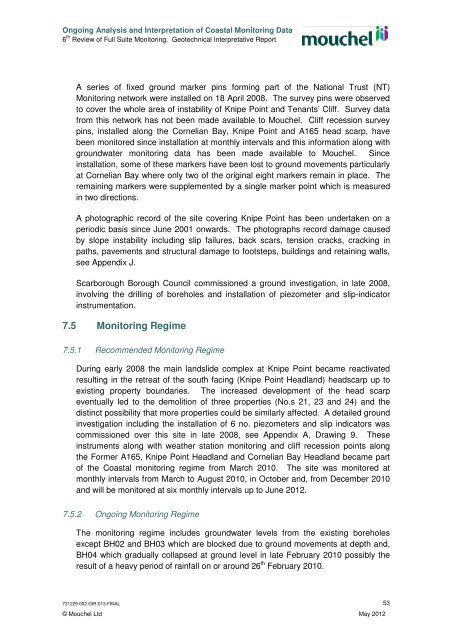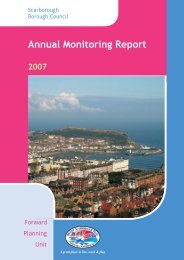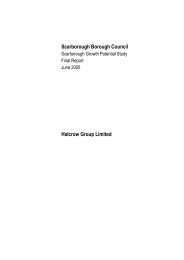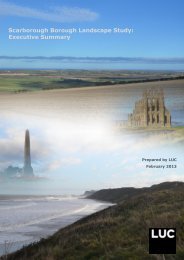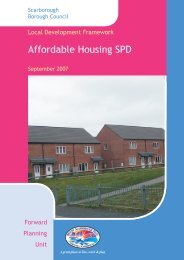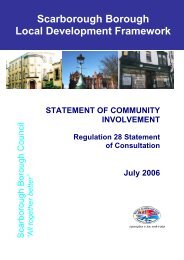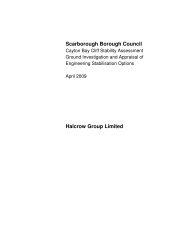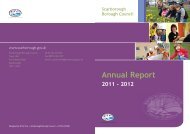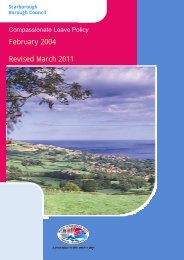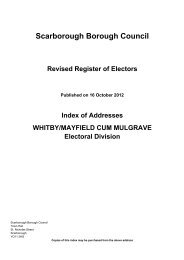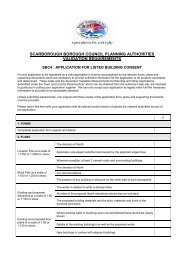Latest monitoring report - Scarborough Borough Council
Latest monitoring report - Scarborough Borough Council
Latest monitoring report - Scarborough Borough Council
Create successful ePaper yourself
Turn your PDF publications into a flip-book with our unique Google optimized e-Paper software.
Ongoing Analysis and Interpretation of Coastal Monitoring Data<br />
6 th Review of Full Suite Monitoring. Geotechnical Interpretative Report<br />
A series of fixed ground marker pins forming part of the National Trust (NT)<br />
Monitoring network were installed on 18 April 2008. The survey pins were observed<br />
to cover the whole area of instability of Knipe Point and Tenants’ Cliff. Survey data<br />
from this network has not been made available to Mouchel. Cliff recession survey<br />
pins, installed along the Cornelian Bay, Knipe Point and A165 head scarp, have<br />
been monitored since installation at monthly intervals and this information along with<br />
groundwater <strong>monitoring</strong> data has been made available to Mouchel. Since<br />
installation, some of these markers have been lost to ground movements particularly<br />
at Cornelian Bay where only two of the original eight markers remain in place. The<br />
remaining markers were supplemented by a single marker point which is measured<br />
in two directions.<br />
A photographic record of the site covering Knipe Point has been undertaken on a<br />
periodic basis since June 2001 onwards. The photographs record damage caused<br />
by slope instability including slip failures, back scars, tension cracks, cracking in<br />
paths, pavements and structural damage to footsteps, buildings and retaining walls,<br />
see Appendix J.<br />
<strong>Scarborough</strong> <strong>Borough</strong> <strong>Council</strong> commissioned a ground investigation, in late 2008,<br />
involving the drilling of boreholes and installation of piezometer and slip-indicator<br />
instrumentation.<br />
7.5 Monitoring Regime<br />
7.5.1 Recommended Monitoring Regime<br />
During early 2008 the main landslide complex at Knipe Point became reactivated<br />
resulting in the retreat of the south facing (Knipe Point Headland) headscarp up to<br />
existing property boundaries. The increased development of the head scarp<br />
eventually led to the demolition of three properties (No.s 21, 23 and 24) and the<br />
distinct possibility that more properties could be similarly affected. A detailed ground<br />
investigation including the installation of 6 no. piezometers and slip indicators was<br />
commissioned over this site in late 2008, see Appendix A, Drawing 9. These<br />
instruments along with weather station <strong>monitoring</strong> and cliff recession points along<br />
the Former A165, Knipe Point Headland and Cornelian Bay Headland became part<br />
of the Coastal <strong>monitoring</strong> regime from March 2010. The site was monitored at<br />
monthly intervals from March to August 2010, in October and, from December 2010<br />
and will be monitored at six monthly intervals up to June 2012.<br />
7.5.2 Ongoing Monitoring Regime<br />
The <strong>monitoring</strong> regime includes groundwater levels from the existing boreholes<br />
except BH02 and BH03 which are blocked due to ground movements at depth and,<br />
BH04 which gradually collapsed at ground level in late February 2010 possibly the<br />
result of a heavy period of rainfall on or around 26 th February 2010.<br />
721229-002-GIR-013-FINAL<br />
© Mouchel Ltd May 2012<br />
53


